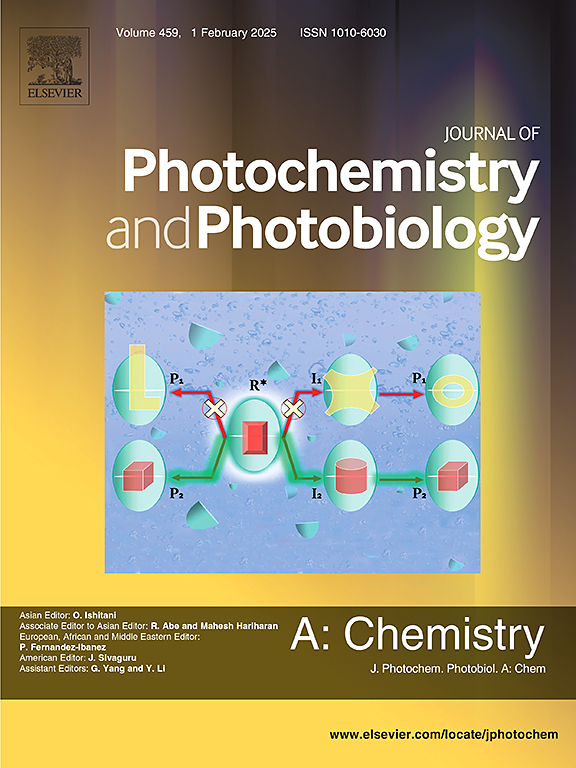Achieving enhanced, tunable and broadened NIR-II emission in Ni2+ doped Li₂Mg₃TiO₆ via cationic substitution strategy
IF 4.1
3区 化学
Q2 CHEMISTRY, PHYSICAL
Journal of Photochemistry and Photobiology A-chemistry
Pub Date : 2025-07-12
DOI:10.1016/j.jphotochem.2025.116605
引用次数: 0
Abstract
Near-infrared (NIR) light has been extensively utilized in biometric identification, food safety inspection, and biomedical imaging. To meet the spectral requirements for NIR detection, phosphors used in the current emerging phosphor-converted light-emitting diodes (Pc-LEDs) must exhibit broadband emission and high photoluminescence quantum yield (PLQY). Enhancing the luminescence efficiency and broadening emission bandwidth of existing NIR emitting phosphors, particularly in NIR-II spectral region (1000–1700 nm), have become critical and urgent research tasks. Inspired by the tunable crystal structure of Li2Mg3TiO6 (LMT), we designed a series of Ni2+ doped broadband NIR-II emitting phosphors, Li2Mg3Ti1-xSnxO6: 0.007Ni2+ (x = 0–1.0), through Sn4+ substitution for Ti4+ in the LMT host, aiming to precisely modulate the crystal field environment around Ni2+. Experimental results demonstrate that the dominant emission peak red-shifts from 1355 to 1474 nm, while the FWHM broadens from 284.97 to 382.53 nm (ΔFWHM = 98 nm) with increasing Sn4+ concentration. Concurrently, the PLQY is significantly improved from 17.3 % to 30.2 %. The phosphors exhibit superior performance in bio-penetrating imaging and spectral detection through cation substitution strategy of NIR emission band broadening and quantum efficiency enhancement. These results present important guiding significance for the development of efficient broadband NIR-II emitting phosphors used in rapidly developing NIR Pc-LEDs.
通过阳离子取代策略实现Ni2+掺杂Li₂Mg₃TiO₆中增强、可调和展宽的NIR-II发射
近红外(NIR)光在生物识别、食品安全检测和生物医学成像等领域得到了广泛的应用。为了满足近红外探测的光谱要求,当前新兴的磷转换发光二极管(pc - led)中使用的荧光粉必须具有宽带发射和高光致发光量子产率(PLQY)。提高现有近红外发光荧光粉的发光效率,拓宽其发射带宽,特别是在近红外- ii光谱区(1000-1700 nm),已成为关键而紧迫的研究课题。受Li2Mg3TiO6 (LMT)可调谐晶体结构的启发,我们设计了一系列Ni2+掺杂的宽带NIR-II发射荧光粉,Li2Mg3Ti1-xSnxO6: 0.007Ni2+ (x = 0-1.0),通过Sn4+取代LMT主机中的Ti4+,旨在精确调制Ni2+周围的晶体场环境。实验结果表明,随着Sn4+浓度的增加,主发射峰红移范围为1355 ~ 1474 nm,峰宽范围为284.97 ~ 382.53 nm (ΔFWHM = 98 nm)。同时,PLQY从17.3%显著提高到30.2%。该荧光粉通过拓宽近红外发射带和提高量子效率的阳离子取代策略,在生物穿透成像和光谱检测方面表现出优异的性能。这些结果对于开发高效宽带NIR- ii发光荧光粉用于快速发展的NIR pc - led具有重要的指导意义。
本文章由计算机程序翻译,如有差异,请以英文原文为准。
求助全文
约1分钟内获得全文
求助全文
来源期刊
CiteScore
7.90
自引率
7.00%
发文量
580
审稿时长
48 days
期刊介绍:
JPPA publishes the results of fundamental studies on all aspects of chemical phenomena induced by interactions between light and molecules/matter of all kinds.
All systems capable of being described at the molecular or integrated multimolecular level are appropriate for the journal. This includes all molecular chemical species as well as biomolecular, supramolecular, polymer and other macromolecular systems, as well as solid state photochemistry. In addition, the journal publishes studies of semiconductor and other photoactive organic and inorganic materials, photocatalysis (organic, inorganic, supramolecular and superconductor).
The scope includes condensed and gas phase photochemistry, as well as synchrotron radiation chemistry. A broad range of processes and techniques in photochemistry are covered such as light induced energy, electron and proton transfer; nonlinear photochemical behavior; mechanistic investigation of photochemical reactions and identification of the products of photochemical reactions; quantum yield determinations and measurements of rate constants for primary and secondary photochemical processes; steady-state and time-resolved emission, ultrafast spectroscopic methods, single molecule spectroscopy, time resolved X-ray diffraction, luminescence microscopy, and scattering spectroscopy applied to photochemistry. Papers in emerging and applied areas such as luminescent sensors, electroluminescence, solar energy conversion, atmospheric photochemistry, environmental remediation, and related photocatalytic chemistry are also welcome.

 求助内容:
求助内容: 应助结果提醒方式:
应助结果提醒方式:


